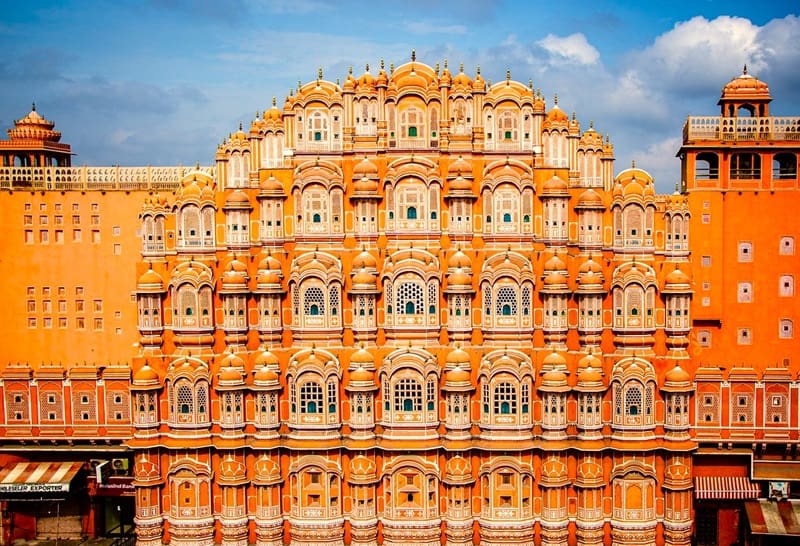Jaipur: India’s Pink City
Jaipur is the capital city of the Indian state of Rajasthan. It is one of India’s most popular tourist destinations, known for its rich history, stunning architecture, vibrant culture, and colorful traditions.
Jaipur is known as the “Pink City” because of its distinctive pink-colored buildings. The story behind this unusual pink color dates back to the late 19th century.
In 1876, Maharaja Sawai Ram Singh of Jaipur ordered the city to be painted pink to welcome the Prince of Wales and Edward VII, who were visiting India. Pink was chosen because it was associated with hospitality and intended to create a sense of warmth and welcome for the royal guests.
Since then, Jaipur has maintained this tradition of painting its buildings pink, and today, it’s a city ordinance that mandates that many buildings in the old part of the city (the walled city or Pink City) be painted in shades of pink. This gives Jaipur its distinctive and charming appearance, and it has become one of the city’s most recognizable features.
The pink color of Jaipur’s buildings has preserved a historical tradition and become a city symbol, making it a unique and visually appealing destination for tourists and visitors.
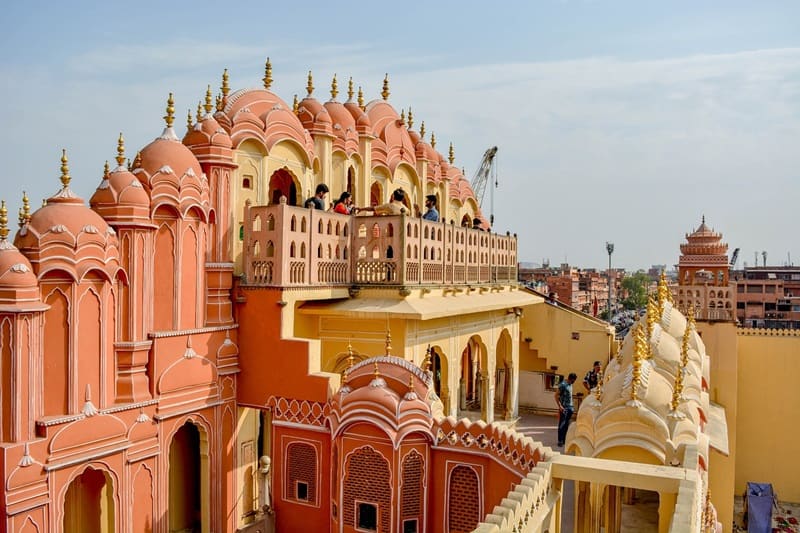
This post may contain affiliate links. Please read our disclosure and privacy policy for more information.
History of The City of Royals
The history of Jaipur City is rich and dates back to the 18th century when Maharaja Sawai Jai Singh II founded it.
Jaipur was founded in 1727 by Maharaja Sawai Jai Singh II, the ruler of the Kingdom of Amber (now Amer), the previous capital. The decision to move the capital to Jaipur was made for several reasons, including the need for a better-planned city, increased population, and improved water supply.
Vidyadhar Bhattacharya, a Bengali architect, meticulously planned and designed the city. The layout of Jaipur is based on the principles of Vastu Shastra and Shilpa Shastra, ancient Indian texts on architecture and town planning.
Places To See in Jaipur:
Jaipur has always been a center of art, culture, and tradition. It is known for its magnificent palaces, forts, temples, and Havelis.
The City Palace, Amber Fort, Hawa Mahal, and Jantar Mantar are some of its architectural jewels. Let’s See in Detail what makes Jaipur a magnet for travel lovers.
Amber Fort (Amer Fort)

Amber Fort, also known as Amer Fort, is one of Jaipur, Rajasthan, India’s most iconic and majestic historical attractions.
It is located atop a hill called Cheel ka Teela (Hill of Eagles) in Amer, about 11 kilometers from Jaipur’s city center.
Amber Fort is a UNESCO World Heritage Site known for its stunning architecture and historical significance.
Amber Fort is a prime example of Rajput architecture, blending Hindu and Mughal architectural styles. The fort’s imposing walls and grand gateways lead to courtyards, palaces, temples, and gardens.
Amber Fort is a testament to the grandeur and luxury of the Rajput rulers of Rajasthan. It’s a must-visit destination for history enthusiasts, architecture lovers, and anyone interested in experiencing the rich heritage of Jaipur and the region.
Entry Fees: Indian: Rs. 25.00, Student: 10
Timings: 8 am to 5 pm and 7 pm to 10 pm
Jaipur City Palace
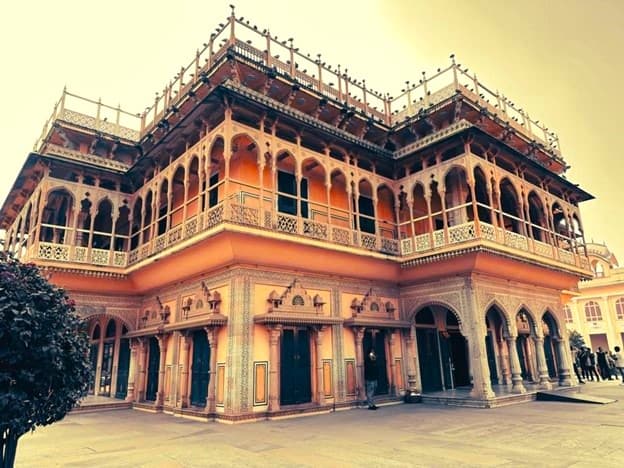
The City Palace in Jaipur is a magnificent royal residence and a major tourist attraction in the heart of the Pink City.
It is a prime example of Rajput and Mughal architecture and offers a glimpse into the opulent lifestyle of the royal families of Jaipur.
The construction of the City Palace began in the early 18th century and continued over several generations of rulers of the Kachwaha Rajput dynasty. The palace complex was the seat of the Maharaja of Jaipur, who ruled the region.
City Palace is a beautiful blend of Rajput, Mughal, and European architectural influences. It showcases intricate artwork, decorative elements, and exquisite design.
The City Palace hosts an evening sound and light show that narrates the history of Jaipur and the palace. It’s an engaging way to learn about the city’s heritage.
Entry Fees: INR 200 (Indian)
Timings: 9:30 am – 5:00 pm (Day Visit), 7:00 pm – 10:00 pm (Night Visit)
Hawa Mahal (Palace of Winds)
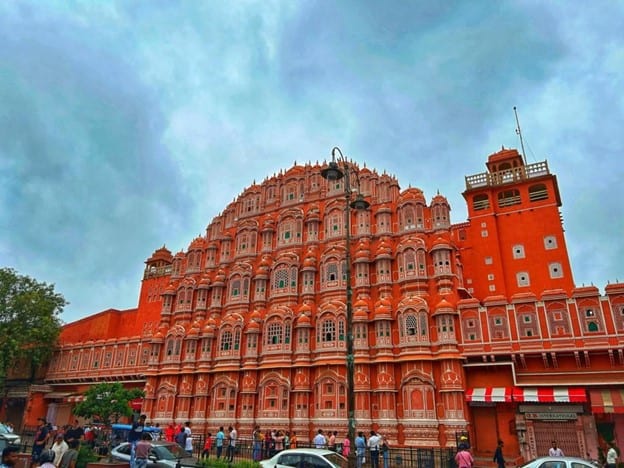
Hawa Mahal, also known as the “Palace of Winds,” is a famous architectural landmark in Jaipur, Rajasthan, India.
The Mahal is renowned for its unique and intricate architectural design. It was built in 1799 by Maharaja Sawai Pratap Singh, a member of the Kachhwaha Rajput dynasty.
The palace is constructed using red and pink sandstone, a characteristic feature of Jaipur’s architecture.
The primary purpose of Hawa Mahal was to serve as an extension of the City Palace. Its distinctive feature is the presence of 953 small windows, known as “jharokhas,” adorned with intricate latticework.
These windows were designed to allow the royal ladies of the court to observe street festivities and daily life in the city without being seen themselves.
The latticework also provided natural ventilation and cool the interior during hot Rajasthan summers.
Entry Fees: 50 INR
Timings: 9:00 am – 5:00 pm
Jantar Mantar
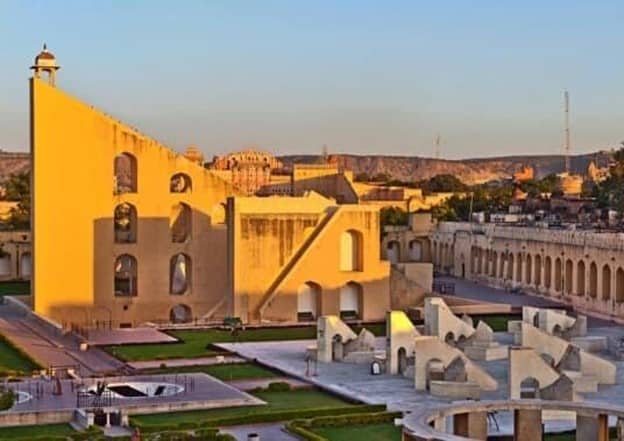
Jantar Mantar in Jaipur, Rajasthan, India, is one of the world’s most significant and well-preserved astronomical observatories.
It is a UNESCO World Heritage Site renowned for its unique collection of architectural astronomical instruments.
Jantar Mantar was built by Maharaja Sawai Jai Singh II, the founder of Jaipur, in the early 18th century. Jai Singh was an avid astronomer and mathematician, and he constructed several observatories across India, with the one in Jaipur being the largest and most impressive.
Jantar Mantar is known for its remarkable architecture, with a collection of 19 architectural instruments that were designed for precise astronomical and astrological observations. These instruments are made primarily of stone and marble.
Entry Fees: 50 INR
Timings: 9:00 am – 5:00 pm
Nahargarh Fort

Nahargarh Fort, also known as the “Tiger Fort,” is a historic fortress on the Aravalli hills overlooking the Pink City of Jaipur in Rajasthan, India.
It is one of the prominent forts in the region and has a rich history and architectural significance.
Nahargarh Fort was built in 1734 by Maharaja Sawai Jai Singh II, the founder of Jaipur
r. The fort was initially constructed as a defense outpost to protect the city of Jaipur from potential attacks from the northwest.
The fort’s name, “Nahargarh,” translates to “abode of tigers.” According to legend, it was believed that the spirit of a Rathore prince named Nahar Singh haunted the area, and the fort was constructed to appease his spirit.
Nahargarh Fort is built in the traditional Rajput architectural style, featuring a mix of Indian and European design elements.
The fortification walls are characterized by large bastions, and the palace structures within the fort showcase the opulent lifestyle of the Rajput rulers.
Entry Fees: 50 INR
Timings: 10:00 am – 5:30 pm
Jaigarh Fort
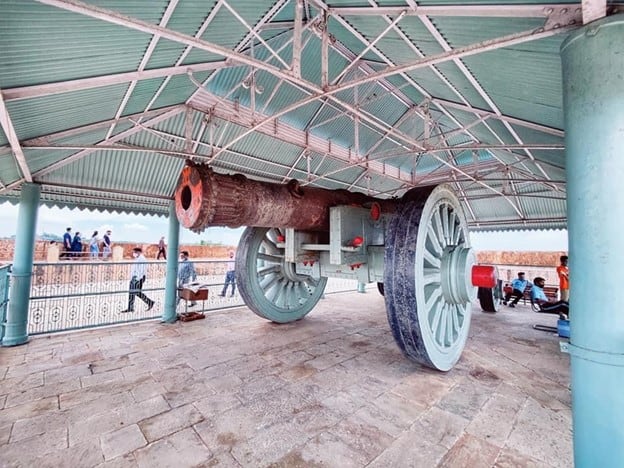
aigarh Fort, also known as the “Victory Fort,” is a historic fortress near the Amber Fort (Amer Fort) in Jaipur, Rajasthan, India.
It is situated on the Aravalli hills and is known for its formidable defensive structures and rich history.
Jaigarh Fort was built by Maharaja Sawai Jai Singh II, the founder of Jaipur, in 1726. It was constructed to protect the Amer Fort and the city of Jaipur from potential invasions.
Jaigarh Fort exhibits classic Rajput military architecture, with massive walls, watchtowers, bastions, and cannon foundries. The fortifications are designed to withstand sieges and attacks.
Entry Fees: 35 INR
Timings: 9:00 am – 4:30 pm
Albert Hall Museum
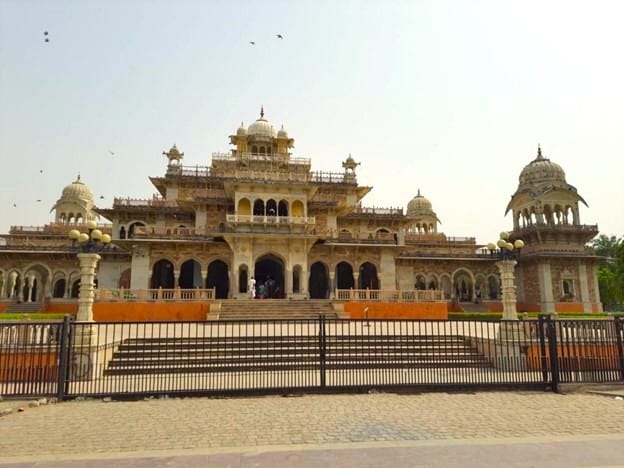
Albert Hall Museum, located in Jaipur, Rajasthan, India, is one of the state’s most prominent and oldest museums.
It is also known as the Central Museum and is housed in a magnificent Indo-Saracenic architectural building.
The Albert Hall Museum was inaugurated in 1887 by Maharaja Sawai Madho Singh II during the visit of the Prince of Wales, Albert Edward, to Jaipur.
It was designed by Sir Samuel Swinton Jacob, an English architect, and is a fine example of Indo-Saracenic architecture.
The museum’s building is a striking blend of architectural styles, incorporating Indo-Islamic, Rajput, and European Gothic architecture elements.
It features intricately designed arches, domes, and ornate pillars, making it a visually stunning structure.
Entry Fees: 40 INR
Timings: 9:00 am – 5:00 pm & 7:00 pm – 10:00 pm
Jal Mahal
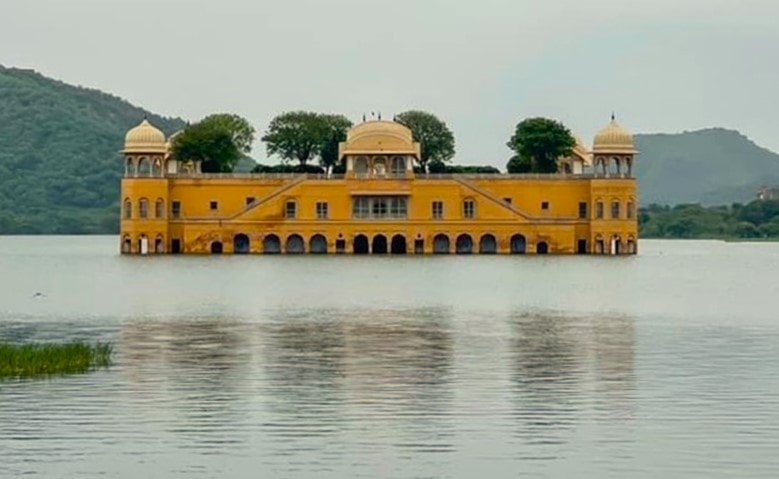
Jal Mahal, which translates to the “Water Palace,” is a stunning architectural marvel in Man Sagar Lake in Jaipur, Rajasthan, India.
It is one of the most iconic landmarks of Jaipur and is known for its unique location and architectural beauty.
Jal Mahal was built during the 18th century, during the reign of Maharaja Sawai Pratap Singh of the Kachhwaha Rajput dynasty.
The palace was constructed 1799 as a royal summer retreat and hunting lodge.
The palace is a fine example of Rajput and Mughal architectural styles. It is a five-story structure with four stories submerged underwater when the lake is entire.
Only the top floor remains visible above the waterline, creating a surreal and captivating sight.
Entry Fees: N/A
Timings: 6:00 am – 6:00 pm
Galtaji (Monkey Temple)

Galtaji, also known as the Monkey Temple, is a famous pilgrimage site located on the outskirts of Jaipur, Rajasthan, India.
It is a unique and picturesque temple complex known for its natural springs, sacred ponds, and the large population of monkeys that inhabit the area.
Galtaji is a significant Hindu pilgrimage site dedicated to Lord Hanuman, the monkey god, and other Hindu deities. The temple complex is associated with various legends and is considered a place of great religious importance.
The architecture of Galtaji is a mix of traditional Rajasthani and Mughal styles. The complex features a series of temples, pavilions, and bathing ghats built from pink sandstone.
Galtaji is also famous for its large population of monkeys, primarily langurs and rhesus macaques, which roam freely within the temple complex.
They are considered sacred and are fed by devotees and tourists.
Entry Fees: Nil
Timings: 5:00 am – 9:00 pm
How To Reach Jaipur?
By Air
The city has its international airport, Jaipur International Airport, located about 13 kilometers (8 miles) from the city center.
It is a significant gateway to Rajasthan and is well-connected to major Indian cities.
By Rail
The city is a major railway junction well-connected to various cities across India. Cabs and rikshaws are readily available.
By Road
A network of national and state highways connects the city.
You can reach Jaipur by bus from nearby cities and states. The Rajasthan State Road Transport Corporation operates a fleet of buses connecting Jaipur to various cities within Rajasthan and neighboring states.
FAQs
Why is Jaipur known as the Pink City?
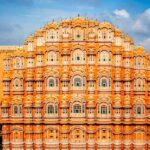
Jaipur is known as the Pink City because of the pink-colored buildings and walls that surround the city’s historic center. The city was painted pink in 1876 to welcome the Prince of Wales, and the tradition has been continued since then.
What are the top tourist attractions in Jaipur?
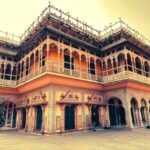
Jaipur has many tourist attractions some of the top ones are:1. Amber Fort 2. Hawa Mahal 3. City Palace 4. Jantar Mantar 5. Jaigarh Fort 6. Nahargarh Fort 7. Albert Hall Museum
What is the language spoken in Jaipur?

The official language of Jaipur is Hindi and Rajasthani, but English is also widely spoken and understood, especially in tourist areas.
Author Bio
Hello, my name is Priyanshu. My friends and I, being avid travelers, always look up to new destinations to explore. This time, we wanted to visit Rajasthan, which happened to be our first choice. Frankly, we were pretty willing to witness the majestic palaces and forts in Rajasthan that we’ve always seen in photographs and movies. Moreover, we were highly excited about the Camel safari.
Looking for more on India? Start Here:
- 8 Reasons Why You Should Travel To India!
- Cordelia Cruises – The Only Way To Cruise in India
- Guhantara Resort Day Out: India’s Underground Resort
- India’s Frozen River – The Chadar Trek
- Rajasthan Destination Weddings
- Southern India: Highlights Of Chennai and Bangalore
- Three Weeks in Asia – How To Travel For Free
- Trekking in the Himalayan Mountains
- Valley of Flowers Trek – India’s Floral Paradise
We participate in the Amazon Services LLC Associates Program, an affiliate advertising program designed to provide a means for us to earn fees by linking to Amazon.com and affiliated sites.
Brit On The Move™ Travel Resources
Ready to book your next trip? Use these resources that work:
Was the flight canceled or delayed? Find out if you are eligible for compensation with AirHelp.
- Book your Hotel: Find the best prices; use Booking.com
- Find Apartment Rentals: You will find the best prices on apartment rentals with Booking.com’s Apartment Finder.
- Travel Insurance: Don’t leave home without it. View our suggestions to help you decide which travel insurance is for you: Travel Insurance Guide.
- Want to earn tons of points and make your next trip accessible? Check out our recommendations for Travel Credit Cards.
- Want To Take A Volunteer Vacation or a Working Holiday? Check out the complete guide to how here!
- Want to Shop For Travel Accessories? Check out our Travel Shop.
Need more help planning your trip? Visit our Resources Page, which highlights the great companies we use for traveling.
